How to DJ Deep House music
Deep house mixing techniques
This complete guide will help you learn to become a Deep House DJ. Its a musical genre I adore for its long melodic sounds and endlessly creative nuances. Allowing for wonderfully long transitions that lend themselves to advanced DJing techniques.
So you want to mix Deep House too right?
I’ve created the ultimate guide to mixing Deep House. The best tips, Deep House DJing tutorials and techniques to improve DJ sets.
Lets get stuck in shall we!
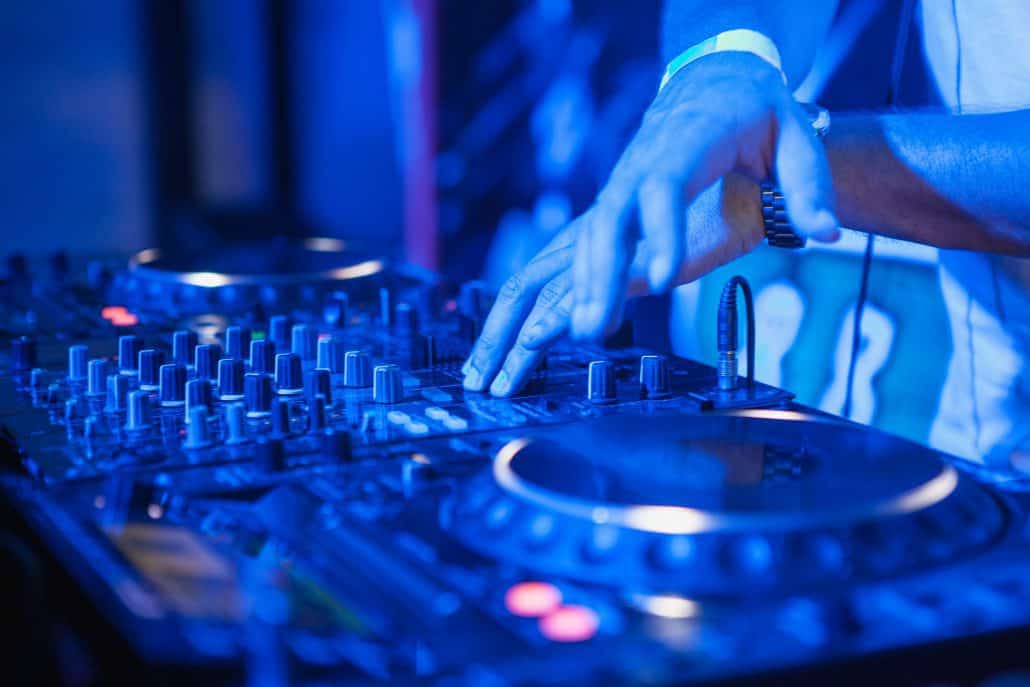
Deep House is a very special type of house music, usually darker in tone than funky house and with its own set of rules and formats. While other house music genres stick to a more formulaic structure, deep house loves to be naughty and break the rules.
There’s a number of characteristics that make up Deep House tracks. So here’s a few of them to look out for. Knowing these layers and structures well will drastically improve your DJ-ing skills with Deep House.
Deep House tracks have long extended sections
There’s no quick verses and choruses here. 3 minutes of repetitive build up adding layer upon layer of sounds in an increasingly menacing or beautiful tone are what you can expect from deep house.
You’ll often hear loops of sounds, vocals and effects layered building up and down throughout the track, creating an atmosphere through these layers rather than letting the vocals do the talking.
Deep House is all about the feeling it produces within you, so long layer rich sequences are key to a good Deep House track.
Almost every Deep House tune can be broken down in to a number of layers.
In order to mix Deep House well you need to understand each of these layers, their patterns and formats as well as how you can identify them. Beat-matching isn’t enough to mix Deep House, knowing what to expect from each of these layers will make your DJ sets and long transitions so much more creative!
The Deep House production layers are:-
- Percussion
- Bass
- Melodies
- Vocals samples
- One shot or loops sound effects
Let’s break it down further and explore each of these.
Percussion
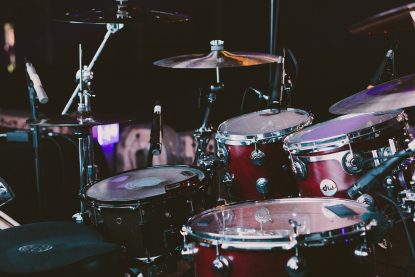 From minimalist beats to complex rhythmic percussions, Deep House has it all. The idea is to create an atmosphere and this can be done with every layer of Deep House.
From minimalist beats to complex rhythmic percussions, Deep House has it all. The idea is to create an atmosphere and this can be done with every layer of Deep House.
You’ll often find the percussion building up from something fairly simple, to a crescendo of layered percussive sounds. Building that intensity up and often bringing it back down again during the track.
While other dance music genres often stick to specific patterns of percussion or types of instrument, Deep House is lucky enough to accommodate pretty much anything.
Short glitchy synthesiser percussions, afro beats, analog or heavily sampled percussion all work within this genre, so expect to hear everything in your deep house playlists.
Because of this you’ll find you can be super creative with your DJ mix transitions. Drop the low and some of the mid frequencies from your incoming track and you can add another layer of percussion to your primary track. Slowly adjust the EQ controls on your mixer between the two tracks and you can seamlessly transition from one to the other, sometimes over 1 or 2 minutes.
Percussion plays a vital roll in deep house, many tracks use it sparingly compared to other dance music genres but this is to add to the atmosphere the track tries to create.
Check out a few of the tracks in this mix and focus entirely on the percussion. You’ll see how vital it is to create that mysterious deep mood vibe. Adding intensity by adding more layers of percussion and removing them to create the atmospheric break downs.
Bass
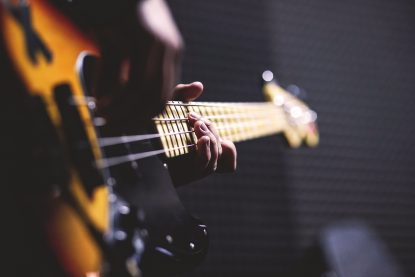 The Bass line in deep house tracks often creates that deep melodic moody sound but you’ll also notice they’re fairly simple in structure. In fact the bass tones and styles don’t vary that much, its just the arrangement of the bass that does.
The Bass line in deep house tracks often creates that deep melodic moody sound but you’ll also notice they’re fairly simple in structure. In fact the bass tones and styles don’t vary that much, its just the arrangement of the bass that does.
Funky House and other dance music genres tend to vary much more with bass sounds, pushing them to the forefront in order to make them a part of the track. But Deep house tends not to do this, keeping the bass in the background rather than dominating any part of a track.
There are exceptions to the rule but if you take a listen you’ll find most Deep House Bass-lines are more subtle.
Having said that they still play and important part in creating that darker deeper sound. Deep House would be nothing without bass.
Melodies
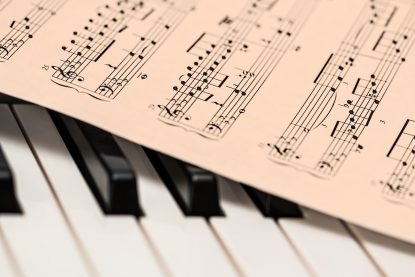 While the percussion and bass add those background layers, sitting right in the foreground is the melodies.
While the percussion and bass add those background layers, sitting right in the foreground is the melodies.
Most Deep House tracks make use of melodies and harmonies in 2 ways
- Higher frequency sounds that tend to be delicate and add a layer of “beauty” to the otherwise deep and dark sound.
- Mid and lower frequency sounds that add that extra “serious” sound to the track, helping to create the distinctive “deep” vibe
Tracks don’t have to always feature both of these but more often than not you’ll hear them in the track somewhere.
Vocals samples
 There are plenty of instrumental deep house tunes out there so vocals aren’t always required but they can add a real extra layer to a track. Unlike other dance music genres they aren’t always pushed to the foreground either.
There are plenty of instrumental deep house tunes out there so vocals aren’t always required but they can add a real extra layer to a track. Unlike other dance music genres they aren’t always pushed to the foreground either.
Short loops of vocals often work well and you’ll rarely hear any verse & chorus structure over a deep house track.
Deep House lends itself to exploring all layers as there is no formulaic structure a track fits neatly in to. So the vocals may never be a big part of the track, or they may well feature heavily.
Thanks to this wide ranging creativity within the Deep House genre you have a lot to play with.
Check out this awesome track with a recognisable vocal sample. It works so well!
The best thing about Deep House is that the tunes have extended progressing sections that can go on for a minute or more at a time, this means you transitions can also be long, subtle, building and intricate too.
Here’s some of the best ways to mix Deep House and why they work so well for this musical genre.
The Seamless transition
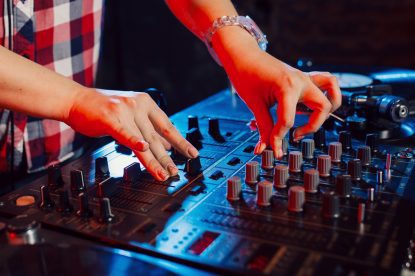 Definitely one of my favourite because the long sections of deep house tracks lend themselves to creating minutely subtle and long mixes.
Definitely one of my favourite because the long sections of deep house tracks lend themselves to creating minutely subtle and long mixes.
When you’re performing a seamless transition in house music you need time and space to adjust multiple faders and dials, so the extended sections of deep house are perfect for this.
Also Deep House is all about those subtle sounds, the layers that are added and removed subtly over time. So your new track coming in is essentially adding more layers to the original track and you can slowly reduce the original tracks dominance because of this.
So here’s how to perform a seamless mix with deep house tracks.
You don’t have to wait until the end of Track 1, you can create a looped section in your DJ software or wait for a break down. But for the purposes of this example we’ll keep it simple and say you’re mixing in near the end of Track 1 when layers start to be removed.
1. Get your tracks in sync
Start playing track 2, starting it on the 1st of 32 beats is usually best as deep house sections tend to be longer than other dance music genres.
Make sure your tracks are perfectly beat matched, either manually (always a good skill!) or by using the sync feature. If you don’t know how to beat match then read my article here. If you’re using the sync button you’ll still need to check its perfectly in sync for the entirety of your transition as software is never perfect all of the time.

2. Cut the bass completely, reduce the high and mid frequencies.
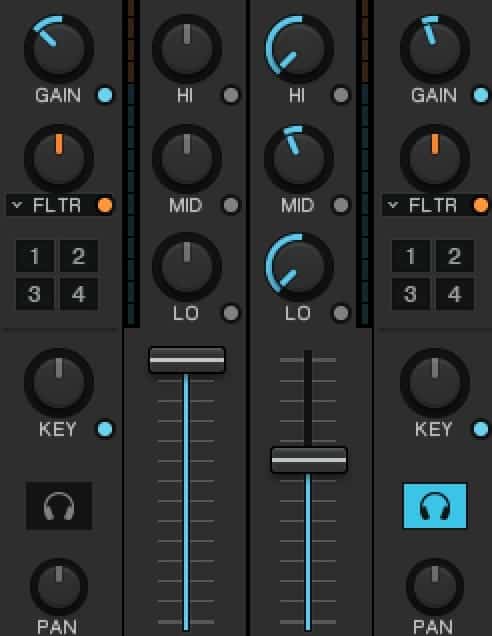 If your mixer can do this then remove the bass completely, since you don’t want any dominant kick drums or bass lines interfering with Track 1’s bass. You’re looking to add percussion and potentially some melodies to track 1, nothing more.
If your mixer can do this then remove the bass completely, since you don’t want any dominant kick drums or bass lines interfering with Track 1’s bass. You’re looking to add percussion and potentially some melodies to track 1, nothing more.
One good tip if you have this feature is to set the cue mix half way so you can hear both track 1 and 2 in your headphones. then cut the bass and reduce the high and mid until you the two tracks sound like one.
This will give you a good indication of the volume levels needed to seamlessly mix the two tracks together.
3. Fade in track 2 or start Track 2 on the 1st of 32 beats.
Knowing when to add Track 2 in to the mix is important, you can either very slowly blend it in to track 1 by increasing the fader of track 2 over 30 – 45 seconds. Or you can pick your moment just right, set the fader to around 80% and hit play on Track 2 on the 1st beat of 32 beat section.
This will then sounds as though a new percussion layer has been added to track 1 without it sounding like a transition at all.
Which approach works best is up to you and the tracks you’re playing. Practice with both and you’ll see what suits each track you play.
4. Start reducing the dominance of track 1
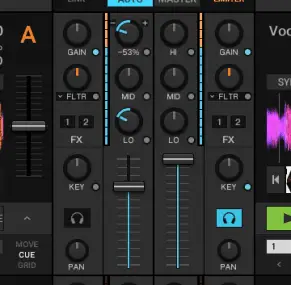 You can keep the mix going for much MUCH longer than many other dance music genres. I’ve been able to perform 2 or 3 minute long transition mixes, here’s how.
You can keep the mix going for much MUCH longer than many other dance music genres. I’ve been able to perform 2 or 3 minute long transition mixes, here’s how.
Once you have track 2 fully established in to the mix you can increase its volume to 100% and start to transition between the 2 bass-lines. Slowly increase the low frequency volume of track 2, don’t lower track 1 yet. you need to look at the peak level meters to see when you’ve got a lot going on, usually around 75% volume for track 2 is the right time to start bringing down the low frequency volume of track 1.
This depends entirely on the sort of bass-lines happening in your two track but it tends to work well.
I recommend finding a good section of track 1 to loop once you’ve let track 2 dominate the transition. You can then mix for as long as you want. Ideally right up until track 2 reaches a breakdown.
Slowly increase the mid and high frequency volumes to 100% on track 2 and reduce them on track 1. I’d recommend reducing the mids more than the highs as the highs contain most of the percussion while the mids will most likely contain some melodies of some sort which ou don’t want clashing with track 2.
5. Let the mix ride!
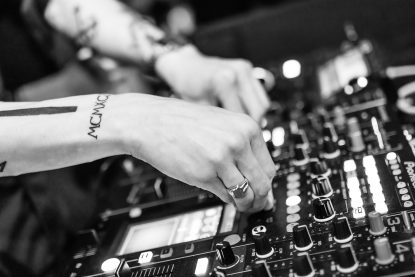 You’ll need to monitor everything acutely now. as you’re effectively creating a whole knew track with layers from both. Adjust the frequency volumes gently making sure everything sounds as one.
You’ll need to monitor everything acutely now. as you’re effectively creating a whole knew track with layers from both. Adjust the frequency volumes gently making sure everything sounds as one.
Keep an eye on the sync of both tracks, if you’re manually beat matching you’ll need to keep the two tracks perfectly aligned, if you’re using the sync button make sure the software still has the two tracks sync-ed.
Sometimes it’ll say its in sync but actually the kick drums may be a little ahead or behind on your beat grid, so be careful.
I love to let the mix go on for as long as I can. Really creating that perfect seamless feel. There’s no need to suddenly cut out track 1 if you don’t want to.
Looping breaks and adding effects.
This transition style works particularly well for Deep house because the breaks can be so long and intricate. It works best if your two tracks are in complimenting keys. Your Dj software should be able to tell you if this is the case.
You don’t have to mix two breaks over each other, beats can work too. Its all about finding the right loops and adding effects to remove the repetitive nature of looping.
Firstly sync your tracks
Get your tracks perfectly beat matched, remember there’s no kick drums or high hats during the breaks to give you those audio and visual cues that your tracks are aligned. Your DJ software should show you a beat grid but as I often say, don’t rely on the sync button or visual cues! You always need to use your ears when DJing!
Start the loop on track 2
I recommend letting Track 1 play and when it reaches the breakdown you want to mix over, bring in a loop already playing in track 2. You can either fade up quickly or you can bring it in slowly with a few effects over the top.

Use effects to make things interesting

Filters are the go-to effect for this but your DJ software has plenty of others like reverb, delay, gater and noise to play around with.
Your loop can often start out unrecognisable from its actual sound, thanks to the effects. The loop will play over and over and you can fade it in more and more until it feels like part of Track 1’s breakdown.
Now loop track 1
During this time you can hit enable on a loop within the break on track 1. Preferably something short like 8, 4 or even 2 bars. Maybe on a particular melody that sounds good looping, or a vocal sample the crowd could chant along too.
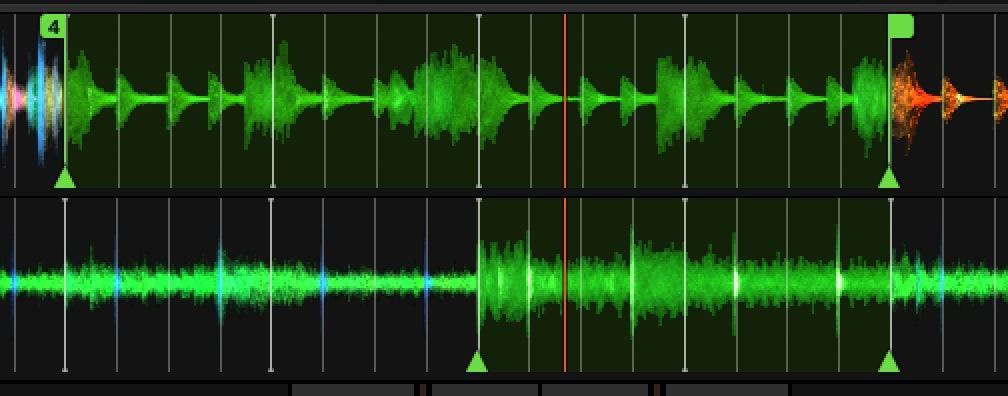
Start working your way out of track 1
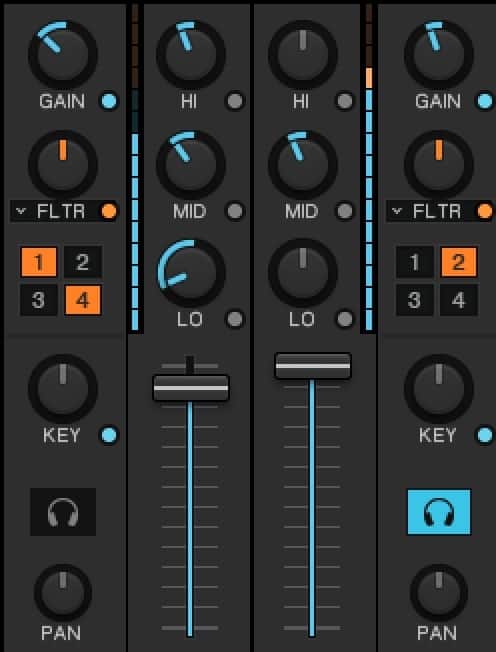 Once you’re doing this time is of the essence. You need to keep things interesting as loops soon get stale if you’re not building them up and switching the focus from track 1 to track 2. So add some effects to track 1, reduce its volume level, reduce some of the mid frequency which is often the key part of any breakdown.
Once you’re doing this time is of the essence. You need to keep things interesting as loops soon get stale if you’re not building them up and switching the focus from track 1 to track 2. So add some effects to track 1, reduce its volume level, reduce some of the mid frequency which is often the key part of any breakdown.
Now its time to let track 2 take over. If your breakdown is long enough you can disable the loop and start letting track 2 play. Now you’ve switched from track 1 playing and track 2 looping, to track 1 looping and track 2 playing!
Let the atmosphere build with the layers you’ve created. Remove the dominance of track 1 by cutting more of the frequencies and adding more of the effects. Lowering the filter is often the easy way to do this, or adding more gater to chop up the loop in to less distinguishable chunks.
Know when to drop track 1 completely
Use your software to see when track 2’s break is coming to an end, and make sure you reduce track 1 down to nothing by this point. You don’t have to of course.
If the loop is interesting enough you can let it play in to the beats of track 1. But just remember you need to end this transition at some point. This is where knowing your tunes inside out really makes a difference.
Mix two tracks of complimenting keys
Modern DJ software should be able to analyse your tracks and tell you what key they are in. This allows you to recognise other tracks of the same key or a key that compliments it.
Now you can mix the two tracks at very different points than before. When keys don’t match you nearly always have to avoid the melodies clashing, but when they keys match the melodies are in beautiful harmony!
And since Deep House is all about the layers, you can now add more harmonic layers to your mixes. Something that can work amazingly well if you pick the right tracks. Here’s a useful key wheel to see which keys work with each other. Essentially you can move from inner to outer key and left or right of your key on the same inner or outer circle. So a 5m track will mix harmonically well with 5d as well as 4m and 6m.
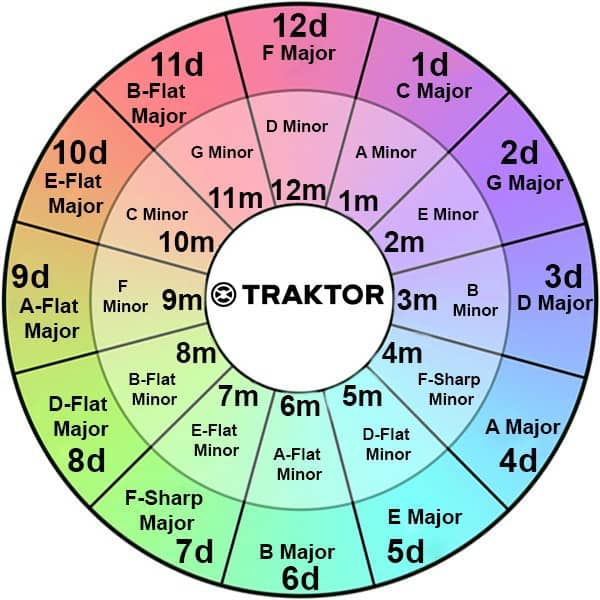
You can use this key mixing technique to blend breakdowns over beats or two breakdowns together, a bass line from one and harmonies from another, or if you’re super creative you could even 4 deck mix some samples and tracks together to create your own multi-layered deep house remix on the fly!
A bonus video worth watching.
Take a moment to check out this mini mix from DJ Hsunami who explains some of his deep house mixing techniques.
I’d recommend a controller with 4 decks if possible because this will allow you to progress from the kinds of transitions and mixes I’ve mentioned in previous chapters, right up to 4 deck looping and percussion samples that can entirely change the way you DJ!
4 deck controllers also tend to be more feature rich with more effects and more opportunities to be creative. Since the layers and long sweeping sections of Deep House lend themselves to this sort of DJing its great to have all those extra features at your disposal.
Just don’t let them overwhelm you. Remember its about subtle use of whats available, not throwing everything at your mixes!
Native Instruments Traktor Kontrol S4 Mk3
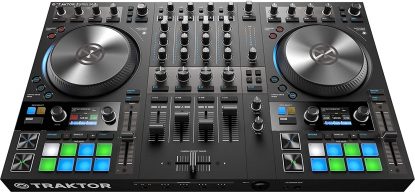 My 4 deck controller of choice at the moment. The S4 Mk3 is a highly intuitive piece of DJ equipment that has everything you need to get super creative with Deep House.
My 4 deck controller of choice at the moment. The S4 Mk3 is a highly intuitive piece of DJ equipment that has everything you need to get super creative with Deep House.
Customisable effects that can be layered in multiple ways, easy looping and controls for jumping to your hot cues and loop points. frequency dials that go right down to zero and the all new haptic response
Traktor Kontrol S8 DJ Controller
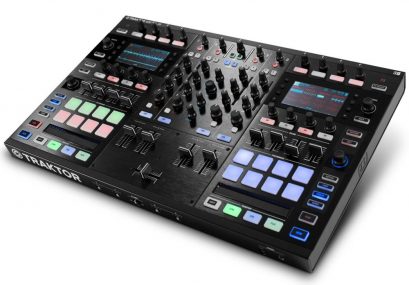 This bad boy is all about the loops and the layers. the S8 was built with the looping, sampling DJ in mind and Deep House is absolutely perfect on this DJ equipment.
This bad boy is all about the loops and the layers. the S8 was built with the looping, sampling DJ in mind and Deep House is absolutely perfect on this DJ equipment.
Added effects, looping and sampling on the fly can all be done with the S8 in real time with plenty of control to make the most of every track.
There are sounds and transitions you can do on this machine that you simply can’t do on others.
And to top it off its perfect for Native Instrument’s own “Stems” music format. You can purchase Stems tracks which are multi-channel audio. Allowing you to drop out the percussion and create acapellas, or switch the percussion for another track. remove the mass or melodies, its endlessly creative!
I’d recommend checking this DJ gear out of you’re serious about Deep House as your chosen DJ career. For the latest price and user reviews go here.
Lower budget mixers and controllers
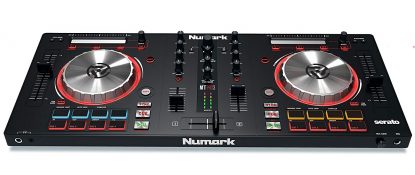 Check out the Numark Mixtrack Pro 3 if you’re on a tight budget but want something with enough features to be creative with your mixes.
Check out the Numark Mixtrack Pro 3 if you’re on a tight budget but want something with enough features to be creative with your mixes.
It’s instantly compatible with Serato DJ software and offers a basic level of sampling and effects. For the latest prices look at Amazon here.
It doesn’t matter what music genre you’re DJing with, you need to add hot cues and loop markers to every track.
Not only is it going to help your DJ-ing creativity but it also forces you to listen to every track and understand its structure, which will be key to creating the perfect transitions.
Hot Cue 1
The start of the track is usually hot cue 1. You Dj software may differ but mine gives me up to 8 hot cue or loop points. So I make sure I make use of all of them!

Hot cue 2
It’s important to know when your track really kicks in. If it starts off with a minimalist drum pattern there’s nearly always a moment where the bass line and maybe some melodies kick in. This is where you want hot cue point 2.

Hot cue 3
Depending on the length of your track this cue point might be just before the crescendo before a break down. Giving you a great point to jump to if you want to keep the energy high.

Be warned this cue point will probably clash with your already playing track if you’re not careful as there’s a lot more melodies and sounds going on now.
Hot cue 4 (or loop)
I always try and put this at the start of the breakdown. So if I want I can jump straight to that point where this track should definitely take over from Track 1 that’s already playing.

You can also use this point to create a loop which you can use over Track 1 to add some familiarity early on in your transition phase.
This works especially well if both tracks are in complimenting keys. See my article on advanced DJ mixing tutorials for more on in-key transitions.
Hot cue 5
The start after the break down. Useful if you want to cut short the breakdown or even skip it altogether. You’re actually more likely to use this hot cue point to extend the high energy section but jumping back to here. Great if your crowd are really in to this track and you want to give them more!

Hot cue 6
There’s nearly always a second breakdown so I put hot cue point 2 here. This is super useful if you did jump back to Hot cue point 5 but now want to break it down once more. Why wait when you can jump right there!

Its also another good point to loop from if you’re planning on key matching and mixing two breakdowns together.
Hot cue 7
I always put this one near the end of the track at a point where the track starts to remove layers on its way out. This is probably my least used hot cue but its always handy to use if you need to extend the transition period and don’t want to use a loop!

Hot cue 8 (Nearly always a loop!)
I always love to have a loop here. This is always at a point near the end of the track where its generally just some beats and minimal percussion. Something you can use to keep the transition going indefinitely, adding that extra layer of percussion to your incoming track by looping the end of this one!

It also means your track will never end! Giving you plenty of time and space to complete your transition in whatever way you like. This works fantastically well with Deep House because long and creative mixes are often the aim!
Deep House makes use of atmospheric effects and etherial layers of sound that work well with effects you might find on DJ mixers and controllers. This means its relatively easy to add your own creative flair with the effects in your DJ software.
As I always say use effects sparingly. Nobody will be impressed if you slap the reverb up to 100% and leave it there.
Its all about knowing how much to add and more important when to make use of the effects.
 For Deep House music I recommend the following effects. These are built in to Traktor Pro 3 but you’ll find them on nearly all DJ software and pro hardware.
For Deep House music I recommend the following effects. These are built in to Traktor Pro 3 but you’ll find them on nearly all DJ software and pro hardware.
- Filter
- Delay
- Gater
- Reverb
- Noise
Filter
This effect is built in to every DJ controller these days and is a simple way to fade out a track without lowering its volume. You’re essentially filtering out some of the frequencies, either by cutting the top end first or the bottom end.
Either can work with Deep House but be warned, as soon as you turn the dial you’ll be cutting more and more at one end of the frequency range.
It becomes noticeable quickly so I recommend using it quickly just before a breakdown or slowly during a build up.
Delay
This works best over breakdowns because delays and kick drums sound like a big crazy mess. When you’ve tried so hard to beat match and keep tracks in sync (you know how to beatmatch right?) it would be a shame to then throw some extra kick drums thanks to over exuberance with the delay effect!
Good controlled use of the delay effect can re-arrange your track in exciting ways but just know when to cut the effect completely so it doesn’t ruin your transition. This can easily happen with delays!
Gater
A great addition to a long seamless mix, Add more and more to chop up your outgoing track and render it obscured in your mix without dropping out the track entirely.
It can produce some fantastic sounds if used well, I recommend reducing the volume to 75% or less as you add more gater to help merge the new effected sound in to the background.
Reverb
Another for breakdowns only. Percussion and reverbs generally sound awful. On the other hand if you have an in-key non-percussion loop then adjusting the reverb can add something atmospheric to your mix. Generally speaking you’ll never use this one anywhere near 100%. I’d say anything below 50% is probably best.
Noise
On Traktor this is a white noise generator that is calculated around the audio from the track its assigned to. Think of it like a filter effect with added “woosh”. A lot of tracks use this kind of sound when building up the energy so you can add that layer yourself with this effect.
While its a great effect it also gets a bit same-y after a while! So use sparingly in your DJ set. Once or twice is probably about all you can get away with.
More DJing advice for you
So now you know how to DJ Deep House music. Here’s some more tutorials that will help improve your DJ sets.
